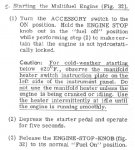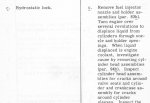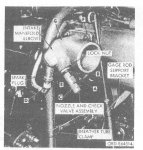- 10,349
- 94
- 48
- Location
- Meadows of Dan, Virginia
Apparently this problem has been with the multifuels since day one. This note is from a 1964 PS magazine (image below).
I assume that they are talking about the flame heater nozzle valves. If that is so and since it is located below the level of the intake manifold, can someone please explain the scenario. How will the fuel end up in the combustion chamber?
The nozzle can leak, I have had one that was leaking, so that's not an issue.
It may be a good idea to check yours or if you don't have a need for it, just disconnect the lines to be safe.
Thanks,
I assume that they are talking about the flame heater nozzle valves. If that is so and since it is located below the level of the intake manifold, can someone please explain the scenario. How will the fuel end up in the combustion chamber?
The nozzle can leak, I have had one that was leaking, so that's not an issue.
It may be a good idea to check yours or if you don't have a need for it, just disconnect the lines to be safe.
Thanks,
Attachments
-
205.1 KB Views: 571







